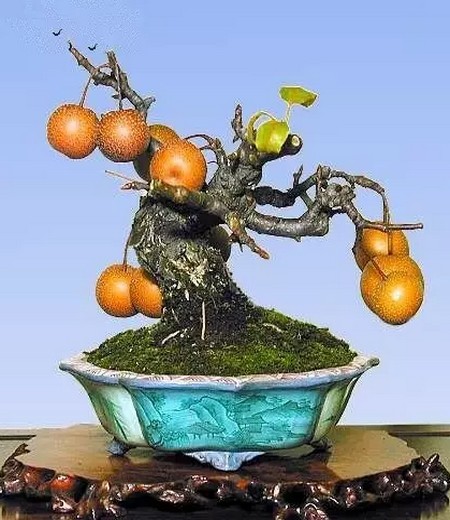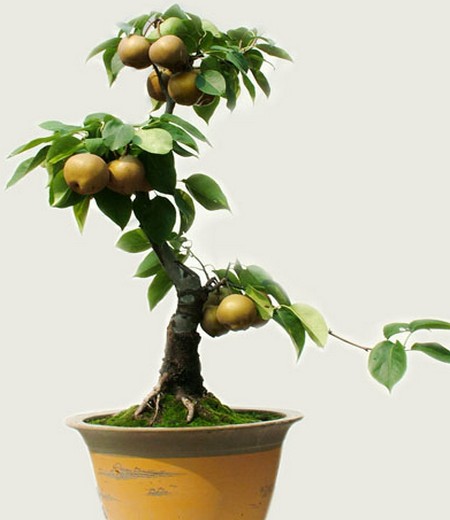Watering skills of pear bonsai
Pear trees need sufficient water supply in the whole growing period, and the leaves of pear trees are very sensitive to water, wilting if there is a little loss of water, and scorching and shedding after a little longer time. In the growing season, such as early flowering, late flowering and long-term fruit speed, such as insufficient water supply, it can directly affect the fruit setting rate, young fruit growth and fruit weight gain in the later stage. Therefore, the growing season should be watered according to the soil moisture in the basin. When the temperature is high and the air humidity is small, spray water on the leaves at noon or in the afternoon. Pay attention to drainage on continuous rainy days. Early spring according to soil moisture timely watering, to prevent the occurrence of strip phenomenon.

The leaves of pear trees are large and thin, and their transpiration is large during the growth period, so they are sensitive to water and avoid drought. When growing, you should fully water and keep the basin soil moist. However, moisture should be properly controlled in the leaf expansion period to control the vigorous growth of branches and leaves, so as to avoid the influence of large leaves and sparse leaves on ornamental. And excessive vegetative growth is not conducive to plant reproductive growth, flower bud differentiation period (generally from the middle of June) should pay attention to reduce the amount of water.
The control of watering water is that the leaves wilt in the afternoon and return to normal in the next morning. if the leaves are still wilting in the next morning, it means that the amount of watering is too little and should be increased appropriately. In this way, the amount of flowering and fruiting of the plant can be significantly increased after 20 days of water control treatment. However, the flowering stage and fruit expansion period should be fully watered, which can be beneficial to stump flowering, fruit setting and fruit growth. Water consumption is fast at high temperature in summer, so the amount of water should be increased and water is often sprayed on branches and leaves to increase air humidity. When the deciduous leaves are dormant in winter, watering should be reduced to keep the basin soil slightly dry.
Because the leaves of pear trees are sensitive to water supply, if the water supply is insufficient, the leaves often wilt, and the leaves will wither and fall off for a long time, especially in the pre-flowering stage, post-flowering stage and fast-growing period of fruit, if there is no sufficient water supply, it can directly affect the fruit setting rate, young fruit growth and fruit weight gain in the later stage. Therefore, it is necessary to dry and irrigate in cultivation to avoid excessive drought of the soil, and to spray water to the leaves as appropriate when the summer is hot and dry.
The middle and lower sentence of June is the period of flower bud differentiation, and short-term drought treatment can be carried out to inhibit the growth of new shoots, increase the proportion of medium and short branches and promote flower bud differentiation by wilting-watering-wilting-watering for about 20 days, and the upper and middle sentences in June can also cut or cut the trunk or main branch in order to increase the proportion of medium and short fruit branches. Watering should be properly controlled in autumn, and soil moisture in the basin should be checked frequently in winter to replenish moisture in time to avoid dry freezing.
Time: 2019-06-11 Click:
- Prev

Pruning method of pear bonsai
Pear trees are suitable for making many different forms of bonsai, such as direct dry type, oblique dry type, curved dry type, double dry type, jungle type, facing water type, horizontal dry type and so on. Because of the large leaves, the crown is mostly in the natural shape, and does not have to be tied into a sheet. Due to the strong growth of pear trees, large annual growth, and vigorous development of top technical strips.
- Next

Fertilization method of pear bonsai
As soon as the stings arrive, the weather begins to get warmer, and there is gradually spring thunder. Sting is the day when God wakes up dormant animals with thunder. Starting today, most parts of China begin to enter the spring ploughing period. Today, many people are interested in the topic that they need to eat pears.
Related
- Fuxing push coffee new agricultural production and marketing class: lack of small-scale processing plants
- Jujube rice field leisure farm deep ploughing Yilan for five years to create a space for organic food and play
- Nongyu Farm-A trial of organic papaya for brave women with advanced technology
- Four points for attention in the prevention and control of diseases and insect pests of edible fungi
- How to add nutrient solution to Edible Fungi
- Is there any good way to control edible fungus mites?
- Open Inoculation Technology of Edible Fungi
- Is there any clever way to use fertilizer for edible fungus in winter?
- What agents are used to kill the pathogens of edible fungi in the mushroom shed?
- Rapid drying of Edible Fungi

